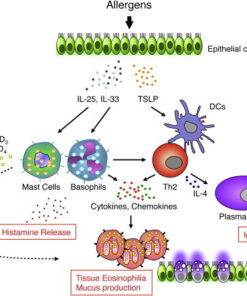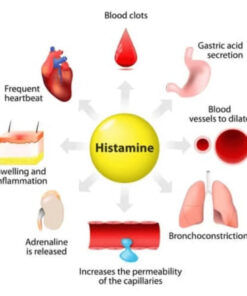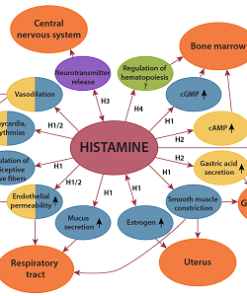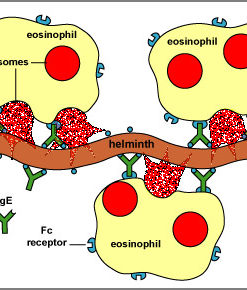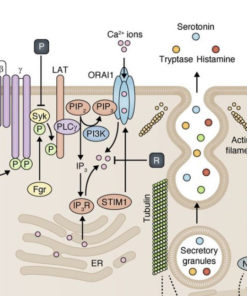Foods and Antigens that Typically Raise Intestinal and Plasma Histamine
Histamine rich foods: Foods that are associated with high histamine levels include fermented foods such as sauerkraut, kombucha, pickles, wine, yogurt, mature cheeses and fermented soy products. It also includes cured, smoked and fermented meats such as salami and sausage, etc. Tomato paste, spinach and canned fish products also have high histamine levels. Citrus foods are histamine liberators which increase histamine release and so should also be avoided.
Histamine is chemically known as a "biogenic amine". Fermented foods have high levels of these biogenic amines. These are foods that are exposed to microbial decomposition as part of the fermentation or in storage. Lactic acid bacteria are the most problematic biogenic amine producers in fermentation. These bacteria break down amino acids into amine-containing compounds. Biogenic amines are commonly found in wines, cider, dairy, meat, fish, beer, spinach, tomatoes and yeast. Biogenic amines in the form of histamine are the product of bacteria breaking down amino acids. Control biogenic amines to treat elevated histamine
Histamine and Lectins
Foods such as potatoes are high in lectins. Lectins can bind the lining of the intestinal wall and cause leaky gut syndrome. Undigested lectins then enter the blood system and lead to antibody formation and which releases histamine. Foods high in lectins include:
· White potatoes and unmodified potato starch
· Tomatoes
· Soy
· Gluten containing grains
· Legumes
Histamine and Probiotics
Probiotics in the digestive tract are responsible for producing many compounds in the body. There are bacterial strains that increase histamine as well as intestinal microbes that reduce histamine.
- Probiotics that increases histamine
- Lactobacillus casei
- Lactobacillus reuteri
- Lactobacillus bulgaricus
Foods, Supplements and Antigens that Lower Intestinal and Plasma Histamine
Histamine and Mast Cells
Histamine is released from “mast cells”. Mast cells are immune cells that line the mucous membranes of the sinuses, digestive tract, the skin, lungs, eyelids, and tissues surrounding blood vessels and nerves. Activation of mast cells plays a key role in asthma, rhinitis, eczema, itching, pain, autoimmunity and hives. Elevated mast cells are associated with female infertility and decreased sperm motility. Stabilize mast cells to treat elevated histamine.
Histamine INTOLERANCE results from a disequilibrium of accumulated histamine and the capacity for histamine degradation. Histamine is a biogenic amine that occurs to various degrees in many foods. In healthy persons, dietary histamine can be rapidly detoxified by amine oxidases, whereas persons with low amine oxidase activity are at risk of histamine toxicity. Diamine oxidase (DAO) is the main enzyme for the metabolism of ingested histamine. It has been proposed that DAO, when functioning as a secretory protein, may be responsible for scavenging extracellular histamine after mediator release. Conversely, histamine N-methyltransferase, the other important enzyme inactivating histamine, is a cytosolic protein that can convert histamine only in the intracellular space of cells.
Diamine Oxidase DAO
This is an important enzyme that naturally lowers intestinal histamine and extracellular plasma histamine. DAO can be provided as a supplement to lower histamine levels. Symptoms of low DAO includes:
- Skin irritations - hives, itching, rashes, eczema, psoriasis, and acne
- Headaches/migraines
- Painful menstrual periods
- Gastrointestinal symptoms
- Intolerance to fermented foods and alcohol
- Mucous in sinuses
- Asthma
Other supplements that either contain DAO or improve levels of DAO:
- White Pea
- Kidney, Placenta and Liver Glandular Extracts
- Vitamin C
- Vitamin B6
- Pancreatic enzymes
- Benadryl (works only temporarily, more histamine receptors will likely develop, potentially worsening condition.)
Supplements and OTC medicines that stabilize mast cells
- Cromalyn sodium (Nasalcrom)
- Quercitin
- Curcumin (also decreases DAO)
- Reishi mushroom
- Yohimbine
- Adrenaline
- Eleuthero
- Rutin
- Theanine
- Astragalus
Probiotics can be used to lower intestinal histamine:
Probiotics in the digestive tract are responsible for producing many compounds in the body. There are bacterial strains that increase histamine as well as intestinal microbes that reduce histamine.
- Decreases histamine
- Bifidobacterium infantis
- Bifidobacterium lognum
- Lactobacillus plantarum
A list of supplements that may be taken to lower plasma histamine and mast cell expression:
- DAO diamine oxidase from natural sources (kidney glandular, placenta and White Pea are sources of naturally occuring DAO)
- Probiotics B infantis, B longum, L plantarum
- Vitamin C
- B6 (can also increase histamine carboxylase)
- Avoid lectin in diet – potatoes and tomatoes
- Avoid fermented foods
- Cromolyn sodium– OTC mast cell stabilizer
- Benadryl (but it lowers DAO and may ultimately cause increased histamine receptor levels)
- Bromelain and Quercitin
- Chocamine – mast cell stabilizer
- Improve adrenals with herbal and glandular supplements
- Curcumin (also decreases DAO)
- NAC N-acetyl cysteine
- Catechins (green tea etc)
- Fatty Acids (long chain and
- Micronutrients- Calcium, Iron, Magnesium Zinc, Phosphorus, B12, B6, Vitamin C,
- Various glandulars
- Various herbs
- White Pea
- Reishi Mushrooms
Biotype Nutrients is a source for purchasing supplements to manage elevated histamine and MAST Cell disorder. The site offers many top name brands and quality sources.
DISCLAIMER - This is a site developed and owned by Second Opinion Physician for the benefit of persons treating elevated histamine and related conditions.
Tests for evaluating MCAS, Histaminosis, Methylation and Allergies
Other Single Item Tests
Walsh Approach Single Tests
Other Single Item Tests
Other Single Item Tests

